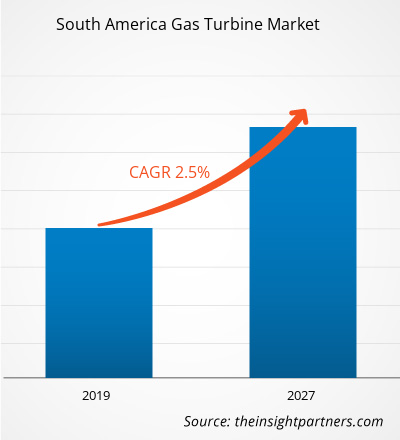The gas turbine market in South America is expected to grow from US$ 1866.94 million in 2018 to US$ 2326.34 million by 2027; it is estimated to grow at a CAGR of 2.5% from 2019 to 2027.
Brazil and Argentina are major economies in South America. The demand for electricity is growing as a result of the increasing population, urbanization, and increase in per capita consumption of electricity. The electricity demand in the coming years is expected to increase hugely of the current demand. The primary gas producing regions such as the Middle East, U.S., and Russia are planning to renovate their infrastructure for electricity generation with gas-based power generation. Latin America is also planning to adopt the similar infrastructure. The demand for electricity is also increasing from industrial establishments and manufacturing plants, is also bolstering the growth of the energy and power industry. The process of electricity or power generation is changing rapidly, and these changes are prompted by the cost of electricity generation and concerns regarding climate change. The usage of coal for electricity generation causes air pollution and GHG emissions. These concerns result in the use of gas turbines as a preferred source of power generation. The gas turbines have become an essential technology for converting conventional fossil fuels into electricity. Thus, the growth in the energy and power sector and need for cleaner source of energy is expected to create a significant demand for gas turbines in the coming years, which is further anticipated to drive the market in South America.
The outbreak of COVID-19 has been affecting economies and industries in various countries due to lockdowns, travel bans, and business shutdowns in South America. So far, Brazil is the worst-hit country followed by Ecuador, Chile, Peru, and Argentina, among others. The energy and power industry is one of the major industries that is suffering serious disruptions such as supply chain breaks, technology events cancellations, office shutdowns etc. as a result of this outbreak. The government of South America has taken an array of actions to protect their citizens and contain COVID-19’s spread. It is anticipated that South America will face lower export revenues, both from the drop in commodity prices and reduction in export volumes, especially to China, Europe, and the United States, which are important trade partners. All these factors are forecasted to affect the energy and power industry in a negative manner and thus act as restraining factor for the growth of various markets related to this industry in the coming months.
With the new features and technologies, vendors can attract new customers and expand their footprints in emerging markets. This factor is likely to drive the gas turbine market. The South America gas turbine market is expected to grow at a good CAGR during the forecast period.
- This FREE sample will include data analysis, ranging from market trends to estimates and forecasts.
The South America gas turbine market Segmentation
South America Gas Turbine Market – By Technology
- Open cycle
- Combined Cycle
South America Gas Turbine Market – By Capacity
- Below 40 MW
- 40-120 MW
- 120-300 MW
- Above 300 MW
South America Gas Turbine Market – By Application
- Power Generation
- Oil and Gas
- Industrial
South America Gas Turbine Market – By Country
- Brazil
- Argentina
- Rest of South America
South America Gas Turbine Market -Companies Mentioned
- General Electric Company
- Harbin Electric Company Limited
- Kawasaki Heavy Industries, Ltd.
- Man Energy Solutions
- Mitsubishi Hitachi Power Systems, Ltd.
- Siemens AG
- Solar Turbines Incorporated
- Wärtsilä Corporation
- Bharat Heavy Electricals Limited (BHEL)
South America Gas Turbine Report Scope
| Report Attribute | Details |
|---|---|
| Market size in 2018 | US$ 1866.94 Million |
| Market Size by 2027 | US$ 2326.34 Million |
| Global CAGR (2019 - 2027) | 2.5% |
| Historical Data | 2016-2017 |
| Forecast period | 2019-2027 |
| Segments Covered |
By Technology
|
| Regions and Countries Covered | South and Central America
|
| Market leaders and key company profiles |
- Historical Analysis (2 Years), Base Year, Forecast (7 Years) with CAGR
- PEST and SWOT Analysis
- Market Size Value / Volume - Global, Regional, Country
- Industry and Competitive Landscape
- Excel Dataset



Report Coverage
Revenue forecast, Company Analysis, Industry landscape, Growth factors, and Trends

Segment Covered
Technology, Capacity, and Application

Regional Scope
North America, Europe, Asia Pacific, Middle East & Africa, South & Central America

Country Scope
US, Canada, Brazil, Argentina
Trends and growth analysis reports related to Energy and Power : READ MORE..
The List of Companies - South America Mobile Access Control Platform Market
- General Electric Company
- Harbin Electric Company Limited
- Kawasaki Heavy Industries, Ltd.
- Man Energy Solutions
- Mitsubishi Hitachi Power Systems, Ltd.
- Siemens AG
- Solar Turbines Incorporated
- Wärtsilä Corporation
- Bharat Heavy Electricals Limited (BHEL)

 Get Free Sample For
Get Free Sample For